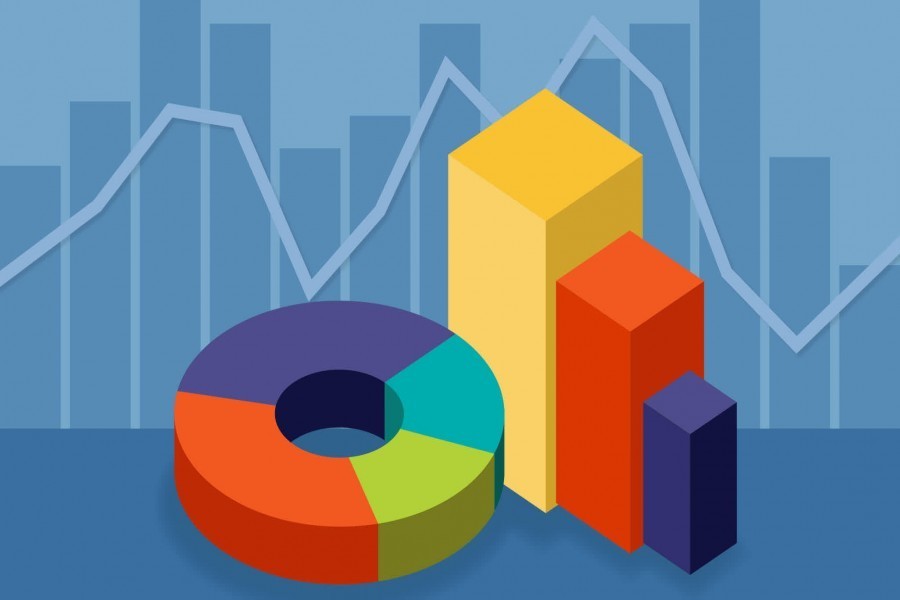Consumption spree in the last fiscal year (FY21) drove the strong rebound of economy amidst the second wave of the pandemic. This is inferred from the final estimation of the Gross Domestic Product (GDP) for the last fiscal year. The national statistical agency released the estimation last week which showed that GDP posted 6.94 per cent growth in FY21. Earlier, the preliminary estimation of Bangladesh Bureau of Statistics (BBS) showed 5.43 per cent growth for FY21. The growth rate declined to 3.45 per cent in FY20 due to negative impact of the pandemic. In the previous year of FY19, GDP posted a robust growth of 7.88 per cent. Thus, the country has experienced a 'V-shaped' recovery.
The final estimation of GDP also showed that the growth rate in FY21 overshot 6.50 per cent, the rate projected in the Eight Five-Year Plan (8FYP). The projected rate was based on 'Covid-19 shock plus recovery' in the year. Again, the finance minister in his budget speech in June last said: "Considering the better-than-expected growth in remittances and the implementation of the large stimulus packages by the government to facilitate economic recovery, the GDP growth rate has been revised at 6.10 per cent for the current fiscal year [FY21]." Definitely he is quite happy now as the final growth rate stood very close to 7.0 per cent.
On the broad-sector perspective, BBS's final estimate shows that the services sector which contributes around 52 per cent of GDP in the year under review, registered 5.73 per cent growth, a fair rebound from 3.93 per cent in FY20. On the other hand, industry sector recorded a 10.29 per cent growth in the past fiscal year reflecting a very strong recovery though the sector's contribution was estimated at 36 per cent of the economy. Agriculture, having only 12 per cent share of the country's official economy, posted a slightly lower growth of 3.17 per cent in the past fiscal year.
In this connection, it is necessary to find the driving force of growth when the pandemic cast shadow on different economic activities. BBS breakdown of GDP by expenditure categories may provide an answer. It showed that total consumption spending in the last fiscal year increased by 14 per cent reaching Taka 26.36 trillion from Tk 23.12 trillion in FY20. As a result, consumption-GDP ratio stood at 74.66 per cent in the last fiscal year, a record high during the last one decade. Though consumption has been contributing around three-fourth of GDP for long, there was a declining trend since FY17. BBS statistics also showed that private consumption stood at 68.78 per cent of GDP which was around 67 per cent in FY20.
Against the overall jump in consumption spending, investment-GDP ratio declined to 31 per cent in FY21 from 31.32 per cent in the previous year. The public investment was almost static in the past fiscal year when private investment dropped to 23.70 per cent from 24 per cent in FY20. This means, investment did not contribute to GDP growth as was expected even after it increased in terms of market price. Domestic investment in the last fiscal year posted 10.30 per cent growth to Tk 10.95 trillion from Tk 9.92 trillion in FY20.
In a plain theoretical language, consumption-led growth depends on higher consumer spending to increase aggregate demand which leads to higher investment and faster economic growth. Investment-led growth focuses on investment to create new capacity that ultimately generate more jobs and so push the aggregate demand along with enhancing the productive capacity.
There is also a strong argument that usually a consumption-driven growth fuels inflation. Now the annual average rate of inflation was only 5.56 per cent in FY21, lower than 5.65 per cent in FY20, which does not endorse the proposition. How to explain the development? Increased consumption means higher demand and higher demand leads to price spiral or inflation. Now, a part of inflationary pressure may be felt immediately and the rest in the nearfuture. The gradual rise in inflation during the first half of the current fiscal year (FY22) indicates that consumption spree in the last fiscal year has contributed to some extent. Due to absence of quarterly and half-yearly data on GDP, it is not possible to see the movement of consumption spending against the monthly inflation rate.
Instead of CPI-based inflation, the GDP deflator may be reviewed which is assumed to be a more comprehensive measure of inflation in an economy. BBS estimate showed that GDP deflator increased by 4.12 per cent in the last fiscal year which was 3.85 per cent in FY20. It indicates higher inflation in the last fiscal year which was not captured in the CPI. The personal consumption expenditure price index also increased by 5.89 per cent against the rise of 4.42 per cent during the period under review. All these figures make it clear that spurt in consumption growth ultimately fuels inflation.
Interestingly, Bangladesh Bank in its quarterly report for April-June period of the last year (Q4FY21) identified the consummation spree behind the growth. "Hefty remittance inflow and low cost finance propelled the consumption expenditure which helped revitalise the growth momentum, outweighing the supply side disruptions following the nationwide lockdown and restrictions in the last quarter of FY21 to limit the spread of delta variant of Covid-19." The central bank report, however, did not make any elaboration regarding the consumption-led growth. Moreover, the brief analysis of the economic growth was based on the national statistical agency's preliminary estimation of GDP. It is to see whether the central bank will come with an analytical insight on consumption-led growth in its annual report for FY21 which is yet to be published.


